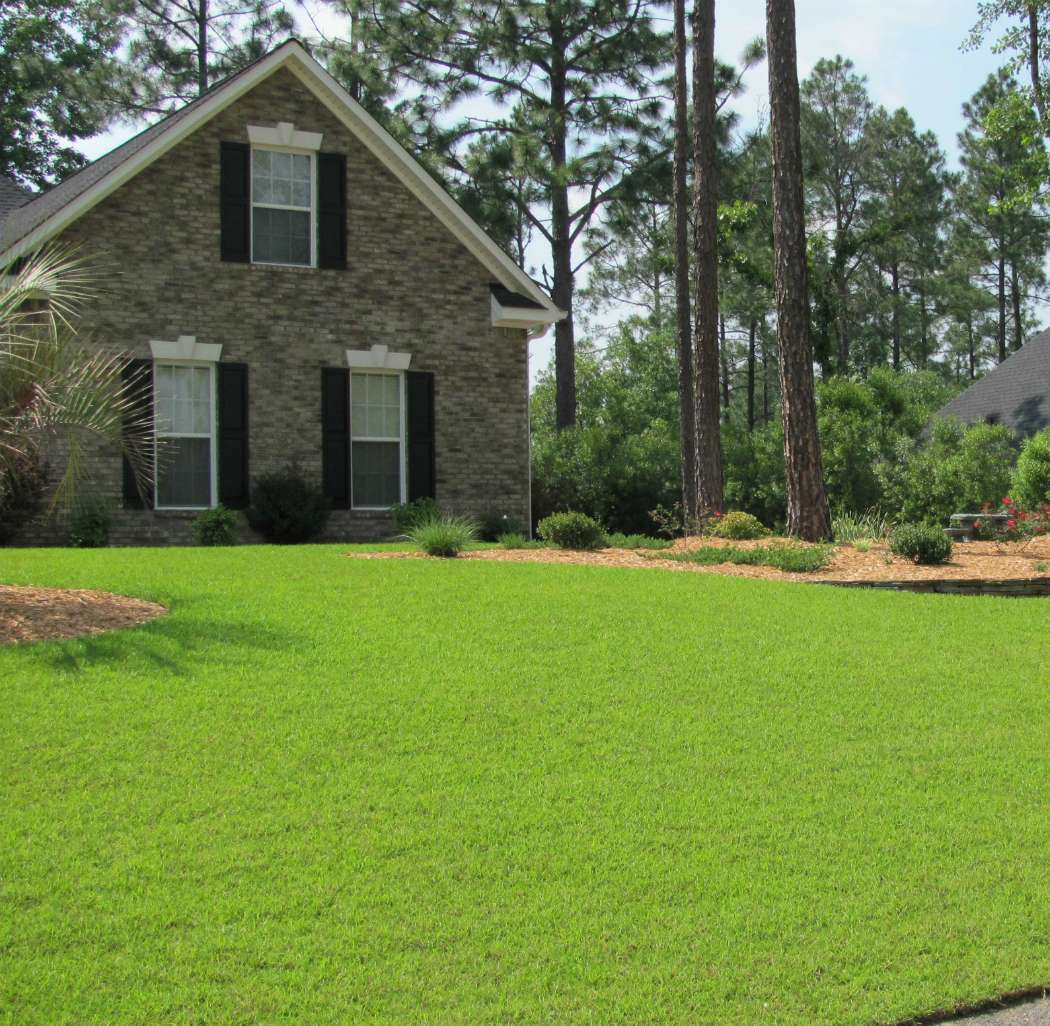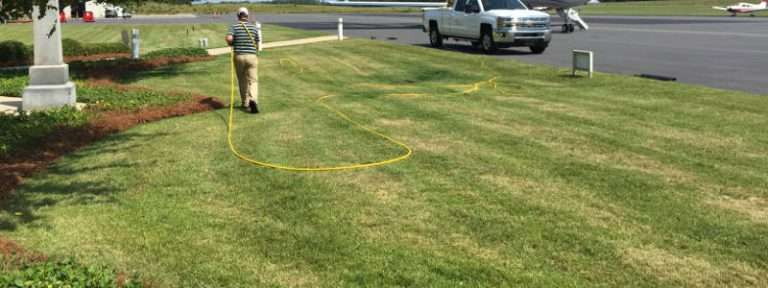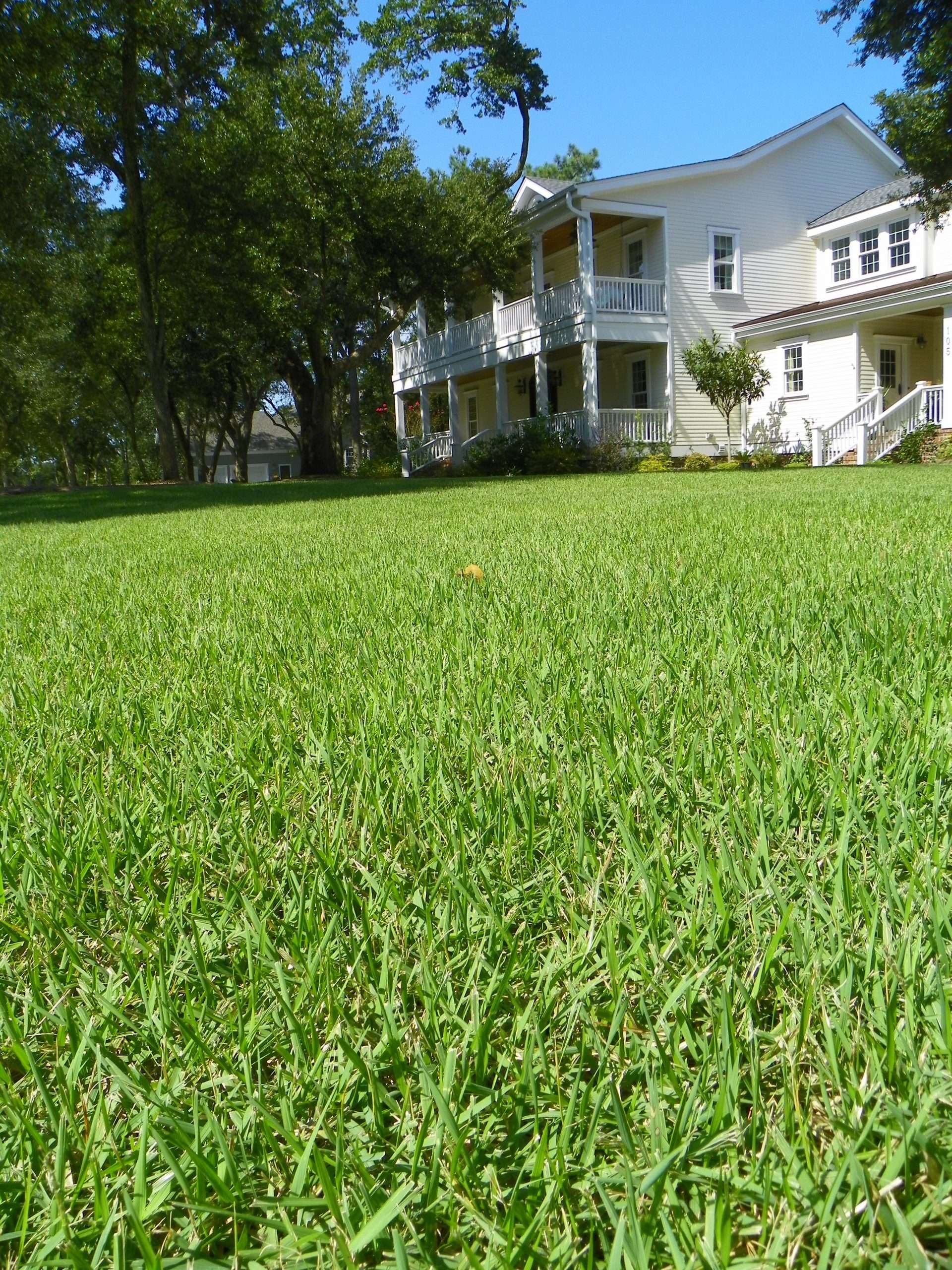Be Wise When You Fertilize
Many trees and landscape plants require little or no fertilizer once they are established and mature. In fact, fertilizers can be hazardous to the health of your yard and the environment when they are misused.
When over-applied, fertilizers may aggravate insect and disease problems and force excessive growth which must be mowed or pruned. Excess fertilizers can run off yards into waterways or seep into aquifers, polluting drinking water.
The decision to fertilize should be based upon the health of the plant, the desired rate of growth, and a soil analysis. A soil analysis will tell you the soil pH and the amounts of nutrients in the soil that are available for plant growth. Soil pH affects the availability of nutrients in the soil. When you choose the fertilizer to use, it should have an analysis, which provides the nutrients that are lacking in the soil.
When Is The Best Times Of The Year To Fertilize And Mow Saint Augustine Grass In South Carolina
Because Saint Augustine grass can be planted year-round, the fertilization will vary.
There are myriad seed and sod options that will rejuvenate and illuminate your South Carolina lawn. Saint Augustine grass is one of several popular grasses in South Carolina. While planting Saint Augustine grass may seem daunting and overwhelming, the experts at Sodbusters will discuss the ways in which you can achieve the perfect South Carolina lawn. Contact Sodbusters today and let our team work with yours.
What Is The Easiest Grass To Grow In South Carolina
Bermuda grass: Because Bermuda grass grows very quickly, it is often regarded as the best grass seed for warm conditions in South Carolina. They can withstand drought and salinity conditions. You may also grow in any sunny place with the utmost care and efficiency. Bermuda grass, on the other hand, is not very cold-resistant.
Don’t Miss: How Do I Treat Clover In My Lawn
Hire A Professional Lawn Care Technician
Maintaining your lawn year-round takes a lot of time and effort, and can be a daunting task. You may prefer to trust a local lawn care company. Coastal Turf, for example, specializes in services including core aeration, sod installation, weed control, and more. If you have questions, call a local technician to discuss specifics in your yard and what you can do to have the best curb appeal in the neighborhood!
Tall Fescue Maintenance Calendar

Factsheet | HGIC 1219 | Sep 28, 2005 |
This calendar of suggested maintenance practices is designed to be a general guide in the care of your fescue lawn. Location, soil type, health of lawn, and other factors affect turf performance. For these reasons, the following management practices and dates should be adjusted to suit your particular home lawn conditions.
You May Like: Where Can I Get My Lawn Mower Serviced
When Should I Do My First Lawn Treatment
Cool-season grasses can be found early in the spring and warm-season grasses in the summer. Dethatching is something you can learn more about. If Crabgrass is a problem in your lawn, its a good idea to apply pre-emergence herbicides to keep the seeds from germinating. This application is very important.
Why Fertilize Your Myrtle Beach Lawn In Fall The Best Month And Time Of Day To Fertilize
The summer heat is stressful on your lawn. The cooler temperatures in fall provide a good setting for your lawn to regain strength before winter arrives.
Fall is the best and most important time to fertilize your lawn because:
- The morning dew delivers moisture to help turf absorb the fertilizer.
- The grass has a chance to build stamina before freezing night time temps arrive
- Supporting root growth in the fall months leads to a healthier, greener lawn in spring.
Don’t Miss: How To Improve My Grass Lawn
Weed Identification And Herbicide Selection
After these cultural problems have been addressed, the weeds of concern must be accurately identified so that the appropriate herbicide may be selected. Proper weed identification is very important because understanding the weeds life cycle is the key to weed management. Herbicides vary in their effectiveness in controlling specific weeds, and some may not provide any control against the targeted weed. Choosing the wrong herbicide due to a misidentified weed can easily result in large amounts of money spent with no control of the weed. Common Weeds and Wildflowers is a complete, up-to-date weed identification guide available from the Cooperative Extension Service. The local Cooperative Extension agent or the Home & Garden Information Center can also help with weed identification, and determine which herbicide will be most effective based on research data and herbicide label information. They can also point out possible concerns when using a specific herbicide. These may include wind drift to nearby plants, volatilization problems, spray water pH and water quality issues, potentially harmful application over root systems of nearby woody plants, and requirements to apply the herbicide during a specific growth stage of the turfgrass or the weed to be controlled.
How Do I Prepare My Lawn For Winter In South Carolina
As the premier grass and sod company, Nimmer Turf, located in Columbia and Mt. Pleasant, South Carolina, we are advising our clients that if they have not begun the winterizing of their lawn, now would be a good time to start. It is recommended that the winterizing fertilizer is applied in October or November. Most lawns become semi-dormant during the winter months and its growth slows dramatically. Depending on the grass, most lawns will lose some of some its dark green color and recovery from damage will also be slowed during the colder months.
However, it is still possible to keep lawns looking their best even during the coldest months. In this article, we will discuss the importance of lawn winterization and offer suggestions for its maintenance during the winter months.
Read Also: Do Robotic Lawn Mowers Work
Do You Have A Palm Tree Keep It Healthy With Fertilizer Stakes
Specialty plants often need more time and attention, especially if they aren’t native to South Carolina. If your yard has a palm tree or two, our team can keep its soil fertilized with stakes, regular applications of manganese-rich fertilizers, and more. Our experts can also create the right regimen for other exotic plants that have a home in your landscaping.
What Fertilizer Has Potassium
Fertilizers that are high in potassium include: burned cucumber skins, sulfate of potash magnesia, Illite clay, kelp, wood ash, greensand, granite dust, sawdust, soybean meal, alfalfa, and bat guano. Some of these fertilizers also contain nitrogen, phosphorus, and other important nutrients for plants.
You May Like: Who Sells Murray Lawn Mower Parts
Fescue Lawn Maintenance For Piedmont Nc
Last week in February or 1st Week in March: If you failed to overseed your lawn in the fall, now is the second-best time to do so. The soil will be puffy from freezing and thawing and you can simply broadcast about 100 lb of Tall Fescue per acre. If you have a shady lawn add about 25 lb per acre of Fine Fescue as they do well in the shade. Raking in the seed will help as well as aerating it in, if the soil is not loose and puffy from winter. Covering the seed with Sides Black Wonder 5000 composted manure will make it super healthy and germinate the seeds. If you do or dont need seed put out about 65 lb of actual slow release nitrogen per acre mixed with pelletized lime to keep your soil from becoming too acidic. We use 27-4-7 slow release or similar mixed with pelletized lime. Put 1 bag of 27-4-7 and 1 bag of pelletized lime in your spreader and use 240 lb per acre of each. If you use another analysis, just make sure it is slow release and high in nitrogen and calculate to put out about 65 lb of actual Nitrogen per acre .
1st Week in May: Now is a good time to clean up your broadleaf weeds such as clover, dandelion, etc. Apply 2-4-D PER THE LABEL. You can use 2-4-D any time to kill broadleaf weeds . If its hot, use a 12 rate or you will risk burning your fescue. Note: No herbicides work well in extremely cold weather. Be careful of damage to turf in hot weather. Read the label.
3rd Week in November: Fertilize just like you did in February, March and September.
When Should You Fertilize Your Lawn

Apr 8, 2021 |
Fertilizing the lawn is a great way to improve its quality and is one component of turfgrass maintenance required to have a thick, lush stand of turf. How much fertilizer to use depends on the turf species. Bermudagrass has a high nitrogen requirement, and if it doesnt receive enough nitrogen, it can become thin and weedy. Centipedegrass has a low nitrogen requirement, and too much fertilizer will lead to turf decline and possibly disease.
Knowing when to apply fertilizer is just as important as using the proper amount. Warm-season grasses are just beginning to green up in South Carolina. It usually only takes a few days in the mid-seventies to see green blades popping up in warm-season lawns. The grass is coming out of winter dormancy, but fertilizing too early can be harmful.
Warm-season grasses, like centipedegrass, bermudagrass, St. Augustinegrass, and zoysiagrass actively grow and thrive when air temperatures are between 75 and 95 ºF. New shoots will begin to emerge once soil temperatures reach 65 ºF at a 4-inch depth. The energy for this new growth comes from carbohydrates that are stored in the crowns, rhizomes, and stolons of the grass. Warm-season turfgrass roots die back in late winter and also need to regrow during spring green-up.
If this document didnt answer your questions, please contact HGIC at or 1-888-656-9988.
Read Also: Where To Dump Old Lawn Mower
Why Should I Winterize My Lawn In South Carolina
The reason that fall fertilizing is so effective is because plants respond to external triggers in fall that start the process of preparing for winter, such as day length and temperature changes. As days shorten and the air becomes cool, turfgrass responds by slowing growth and shifting food reserves from leaves to roots. Although air temperature continues to fall, plant roots remain active in the soil. This is true of many different kinds of plants, including grass.
Shifting excess nutrients to roots is the secret to plants return each spring. Those stored food reserves fuel the spring wake-up. By fertilizing grass in fall, you are feeding the active roots and giving them nutrients to store for winter.
As the weather gets colder, your lawns nutrient needs change in the fall in preparation for the cold weather ahead. Winterizing fertilizers are high in potassium. Potassium is a very important nutrient in overall plant health. Potassium works at the cellular level to strengthen and harden plants from top to bottom, making them more tolerant of cold and stress. Potassium also helps a plant absorb other nutrients, making it an important component of balanced feeding for your lawn.
What Is Best Fertilizer For Bermuda Grass
An N-P-K ratio thats high in nitrogen, contains little or no phosphorus, and may include a small amount of potassium is what the bestfertilizer forBermuda grass should have. A NPK ratio of 16 to 0-8 has 16 percent nitrogen, no phosphorus, and 8 percent potassium. This is a good ratio for the grass of the island.
Read Also: How To Repair Lawn Mower
Fertilizing Your Florida Lawn
When to fertilize your lawn depends on a few things, but the biggest rule is to fertilize only when your lawn is actively growing.
In South Florida, turfgrass grows year-round, while in North and Central Florida, it grows from roughly March or April through September, October, or November.
The maintenance plan you choose also influences when to fertilize. If you choose a higher maintenance plan, youll fertilize more times during the growing season, while a basic plan will require fewer applications.
Look for a fertilizer with at least some slow-release nitrogen, which releases the nitrogen to the grass over an extended period of time. Be sure that it also contains 2% phosphorus or less in accordance with Florida State Law.
How Much Fertilizer Do I Put On My Lawn After Sodding
Apply a starter-type fertilizer, such as 10 pounds per 1,000 square feet of 5-10-10 fertilizer, to kick-start the growth of your plants. When it comes to renovating either cool- or warm-season lawns, sodding is a highly successful method. However, it is particularly beneficial when the lawn is made up of a warm-season turfgrass and the damage is concentrated in a few big places.
Read Also: How To Kill Grub Worms In Lawn
Should I Cut My Bermuda Grass Short For Winter
Mow. Winter mowing of dormant Bermudagrass lawns should be unnecessary, however you may wish to trim edges or uneven places from time to time if they become excessively long. According to the Clemson Cooperative Extension, lawns that have been overseeded with ryegrass should be cut at 1 inch before the grass reaches 112 inches in height before the grass dies.
We Treat A Wide Variety Of Southern Lawn Fungus
Fortunately, here in Lowcountry, home and business owners dont have to simply endure an unsightly, sickly yard full of fungus. Partnering with Coastal Turf, South Carolinas go-to resource for all things lawn care is the first step in reversing your dull, damaged, and deteriorating turf. We offer innovative, effective treatments and solutions that target unwanted fungus to revitalize your property and bring it back to life.
Coastal Turfs team of trained lawn care specialists treat a wide range of common lawn fungi including:
- Brown Patch
- Large Patch
- And More!
Coastal Turf uses the very latest equipment, strategies, and techniques to quickly and effectively stop the spread of disease throughout your residential or commercial properties. No matter whats plaguing your lawn, Coastal Turf will develop a versatile solution, using premium quality products and cutting-edge equipment that puts your yard back on track to health and longevity.
Read Also: How To Reseed An Existing Lawn
Best Time To Fertilize Your Lawn
Spring means more daylight and warmer temperatures. After a cold winter, this is the weather your grass is craving. If youre unsure of exactly when to lay down your first feeding, you can base it off of the temperature. Ideally, the ground should be around 55 degrees Fahrenheit. Depending on where you live, March to April is the best time to fertilize your lawn. Its also best if your yard is watered a few days before you want to apply the fertilizer, whether thats from rain or a sprinkler.
Fertilizer provides your grass with extra nutrients that help to prevent crabgrass and allow it to grow green and thick. To ensure youre laying the feed correctly, start around the perimeter of your lawn. Then, you can start filling in the middle. Similar to mowing your yard, you should go back and forth in straight lines. And you should always use a lawn spreader instead of your hands to complete the job.
Now that you know that spring is the best time to fertilize your lawn, here are some other helpful tips that will keep your grass thriving.
Be Wise When You Fertilize Action Checklist:

Recommended Reading: How To Spray Your Lawn For Mosquitoes
Centipedegrass Yearly Maintenance Program
Factsheet | HGIC 1215 | Revised:Aug 31, 2018 | |
Centipedegrass is a slow-growing, apple-green colored, coarse-leaved turfgrass that is adapted for use as a low maintenance, general purpose turf. It requires little fertilizer, infrequent mowing, and will tolerate moderate shade. However, in order for centipedegrass to grow well, it needs at least 6 hours of full sun. It does not tolerate traffic, compaction, high phosphorus soils, high soil pH, low-potassium soils, excessive thatch, drought, or heavy shade. See HGIC 1209, Centipedegrass for additional information on care and cultivar selection.
Producing a yearly maintenance calendar for managing turfgrass consistently year after year can be difficult in a state with such a diverse climate as South Carolina. Because of this, it is important to monitor temperatures and apply the needed management practices based on that years climate. Important times to monitor the weather are during late winter or early spring when the turf is coming out of dormancy and early fall when the first frost is forecasted. Last frost dates and first frost dates can vary by several weeks to a month from coastal areas of South Carolina to the foothills of the Upstate.
This turfgrass maintenance calendar may be used on turf grown throughout the state however, management practices may need to be adjusted based on the years climate and the region where the turf is grown.
Give New Sod And Garden Plants A Healthy Start With Fertilizer
Well-fertilized soil is even more important for new plants and sod. Fragile flower beds, new hedges, and even young trees have a transitional period when they’re transplanted into your landscaping. During this time, they’re vulnerable to diseases, insects, and even changes in temperature and water access.
Our fertilization experts can keep them safe by supplying the soil with the appropriate levels of nitrogen, iron, manganese, and magnesium sulfate. Our team can provide every section of your yard with the right:
- Liquid fertilizers,
Recommended Reading: How To Treat Lawn Fungus Naturally
